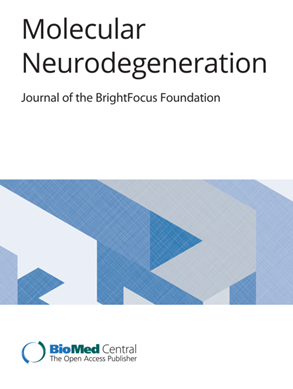TDP-43磷酸化在神经退行性变中的分子机制和后果
IF 17.5
1区 医学
Q1 NEUROSCIENCES
引用次数: 0
摘要
TDP-43磷酸化增加是几种神经退行性疾病的病理标志,包括肌萎缩侧索硬化症(ALS)和额颞叶痴呆(FTD)。然而,TDP-43磷酸化的调控和作用仍然不完全清楚。各种各样的技术已经被用来了解TDP-43的磷酸化,包括激酶/磷酸酶操作,磷酰变异体,以及在各种细胞培养和动物模型中的遗传,物理或化学诱导,以及通过对死后人体组织的分析。这些研究产生了相互矛盾的结果:不一致地表明TDP-43磷酸化可能驱动疾病进展或起到神经保护作用。在这篇综述中,我们探讨了TDP-43磷酸化的调节因子,包括推定的TDP-43激酶c-Abl、CDC7、CK1、CK2、IKKβ、p38α/MAPK14、MEK1、TTBK1和TTBK2,以及TDP-43磷酸酶PP1、PP2A和PP2B在疾病中的作用。基于最近的研究,我们还研究了TDP-43磷酸化对TDP-43病理的影响,特别是与TDP-43错定位、液-液相分离、聚集和神经毒性有关。通过比较各种技术和模型的相互矛盾的发现,本综述强调了对TDP-43磷酸化的理解中的差异和未解决的方面。我们认为TDP-43磷酸化的作用依赖于位点和环境,包括调节液-液相分离、亚细胞错定位和降解。我们进一步建议更多地考虑可能在疾病中受到干扰的TDP-43磷酸化调节因子的正常功能是有必要的。该合成旨在建立对TDP-43磷酸化在神经变性发病机制中的复杂作用的全面理解。TDP-43受激酶磷酸化和磷酸酶去磷酸化的影响,在神经退行性疾病中不同程度地影响蛋白质的定位、聚集和神经毒性。本文章由计算机程序翻译,如有差异,请以英文原文为准。
Molecular mechanisms and consequences of TDP-43 phosphorylation in neurodegeneration
Increased phosphorylation of TDP-43 is a pathological hallmark of several neurodegenerative disorders, including amyotrophic lateral sclerosis (ALS) and frontotemporal dementia (FTD). However, the regulation and roles of TDP-43 phosphorylation remain incompletely understood. A variety of techniques have been utilized to understand TDP-43 phosphorylation, including kinase/phosphatase manipulation, phosphomimic variants, and genetic, physical, or chemical inducement in a variety of cell cultures and animal models, and via analyses of post-mortem human tissues. These studies have produced conflicting results: suggesting incongruously that TDP-43 phosphorylation may either drive disease progression or serve a neuroprotective role. In this review, we explore the roles of regulators of TDP-43 phosphorylation including the putative TDP-43 kinases c-Abl, CDC7, CK1, CK2, IKKβ, p38α/MAPK14, MEK1, TTBK1, and TTBK2, and TDP-43 phosphatases PP1, PP2A, and PP2B, in disease. Building on recent studies, we also examine the consequences of TDP-43 phosphorylation on TDP-43 pathology, especially related to TDP-43 mislocalisation, liquid–liquid phase separation, aggregation, and neurotoxicity. By comparing conflicting findings from various techniques and models, this review highlights both the discrepancies and unresolved aspects in the understanding of TDP-43 phosphorylation. We propose that the role of TDP-43 phosphorylation is site and context dependent, and includes regulation of liquid–liquid phase separation, subcellular mislocalisation, and degradation. We further suggest that greater consideration of the normal functions of the regulators of TDP-43 phosphorylation that may be perturbed in disease is warranted. This synthesis aims to build towards a comprehensive understanding of the complex role of TDP-43 phosphorylation in the pathogenesis of neurodegeneration. TDP-43 is subject to phosphorylation by kinases and dephosphorylation by phosphatases, which variably impacts protein localisation, aggregation, and neurotoxicity in neurodegenerative diseases.
求助全文
通过发布文献求助,成功后即可免费获取论文全文。
去求助
来源期刊

Molecular Neurodegeneration
医学-神经科学
CiteScore
23.00
自引率
4.60%
发文量
78
审稿时长
6-12 weeks
期刊介绍:
Molecular Neurodegeneration, an open-access, peer-reviewed journal, comprehensively covers neurodegeneration research at the molecular and cellular levels.
Neurodegenerative diseases, such as Alzheimer's, Parkinson's, Huntington's, and prion diseases, fall under its purview. These disorders, often linked to advanced aging and characterized by varying degrees of dementia, pose a significant public health concern with the growing aging population. Recent strides in understanding the molecular and cellular mechanisms of these neurodegenerative disorders offer valuable insights into their pathogenesis.
 求助内容:
求助内容: 应助结果提醒方式:
应助结果提醒方式:


